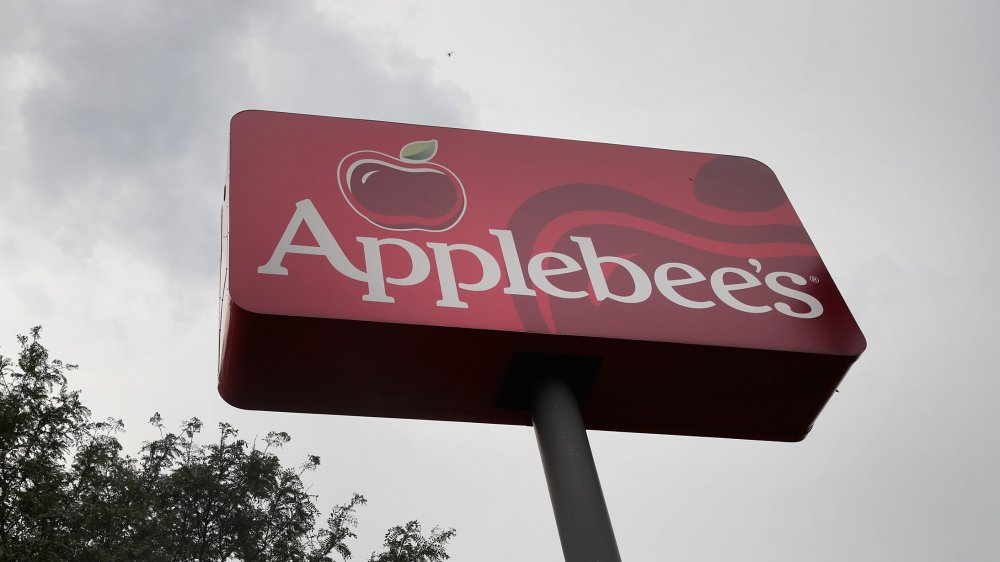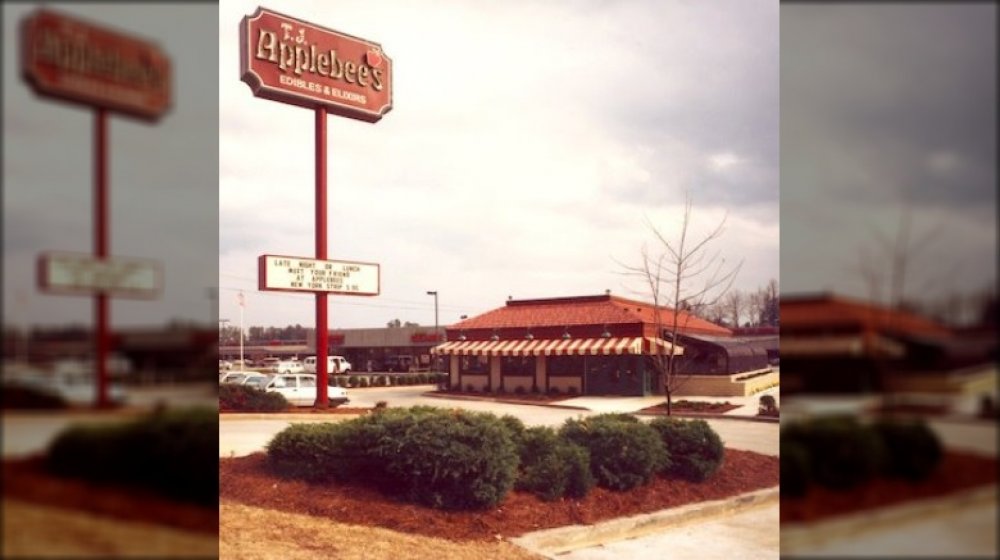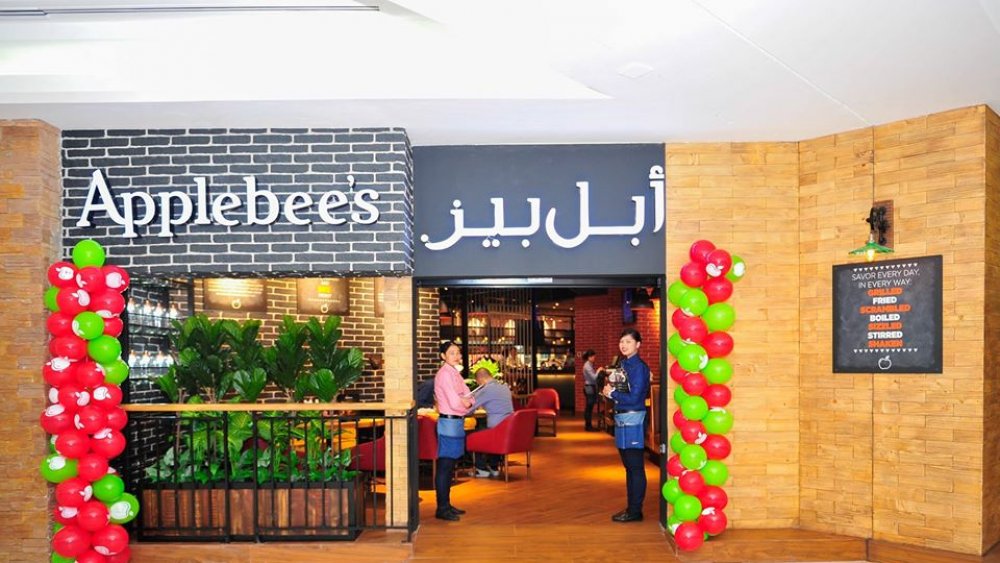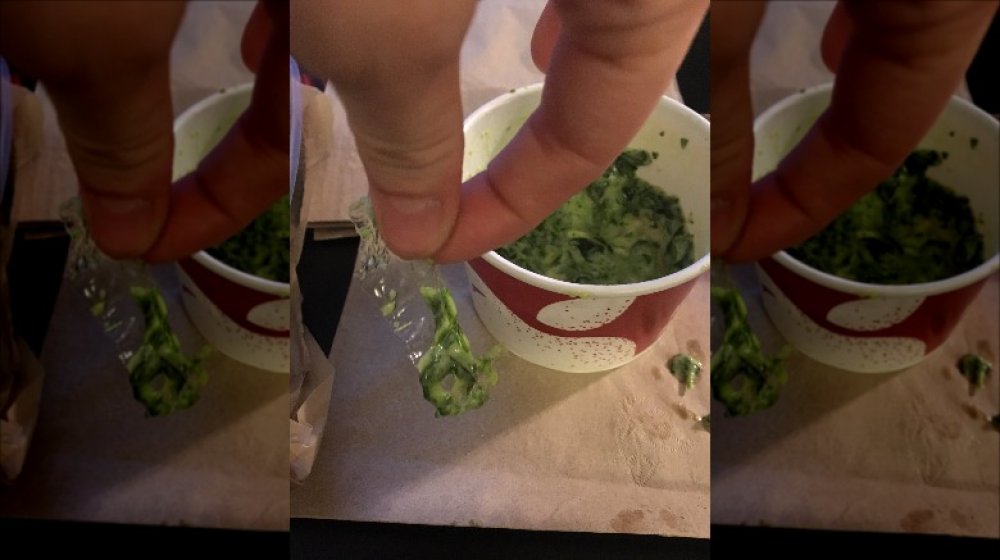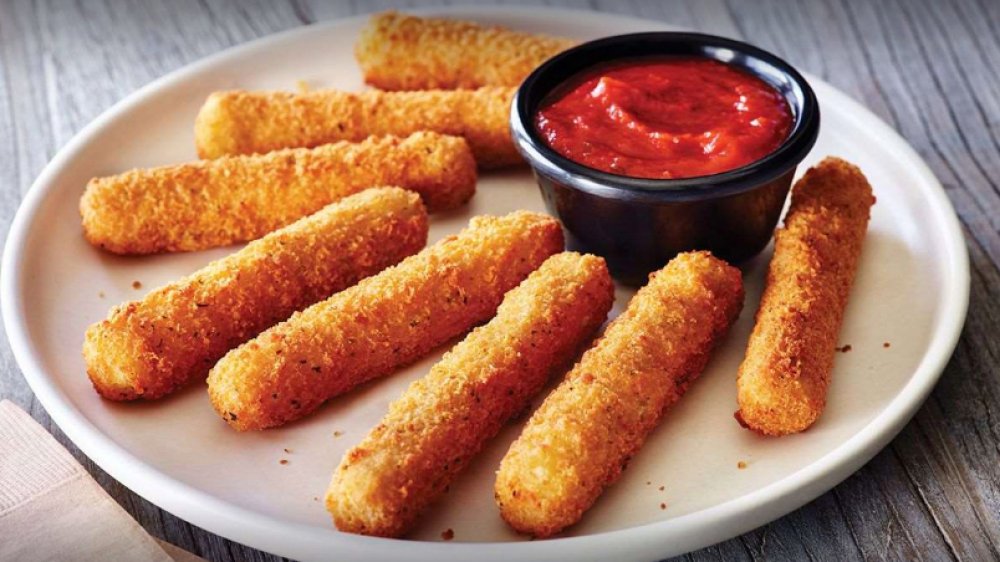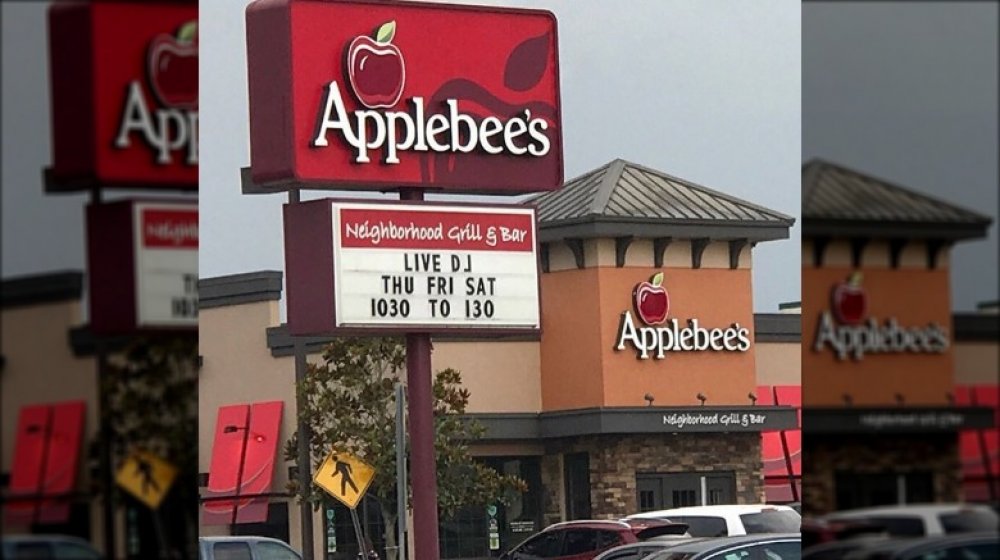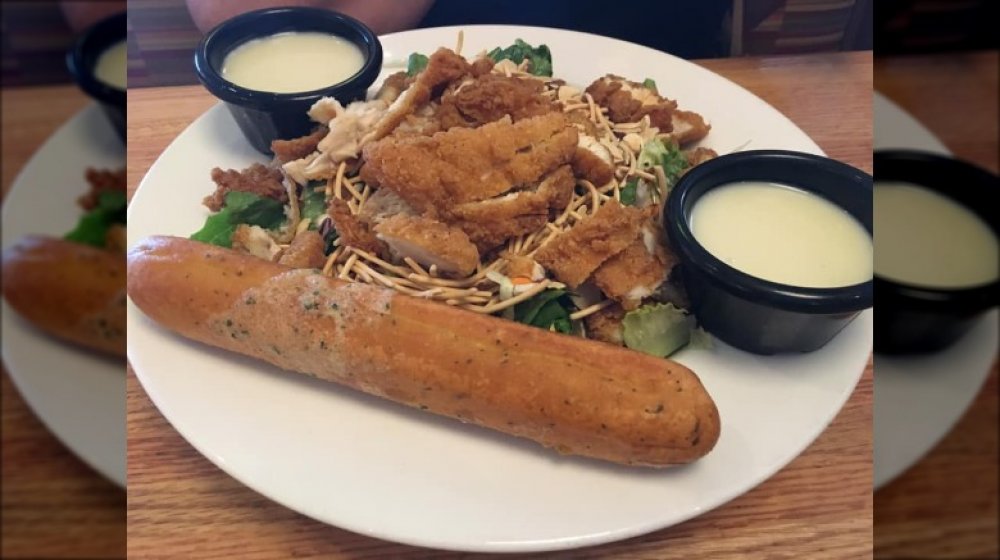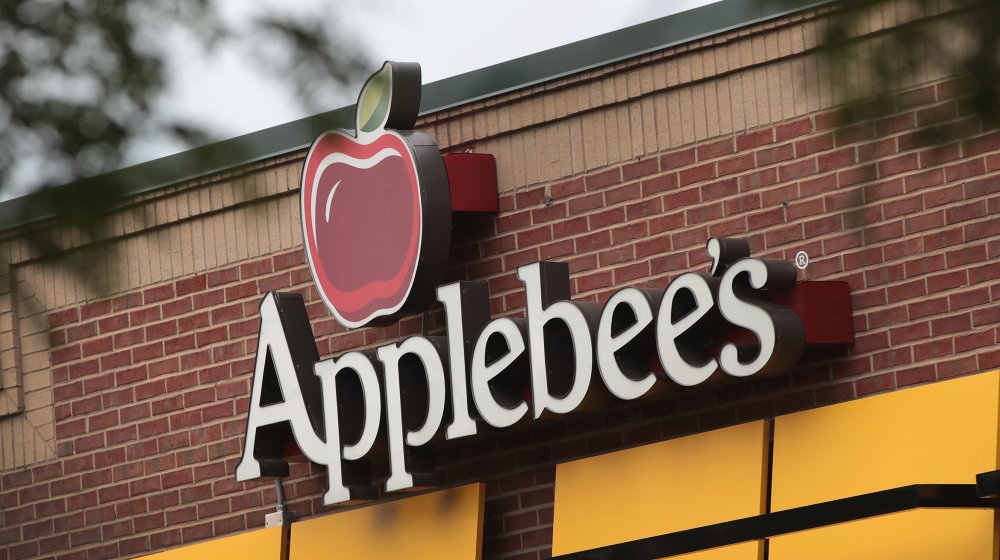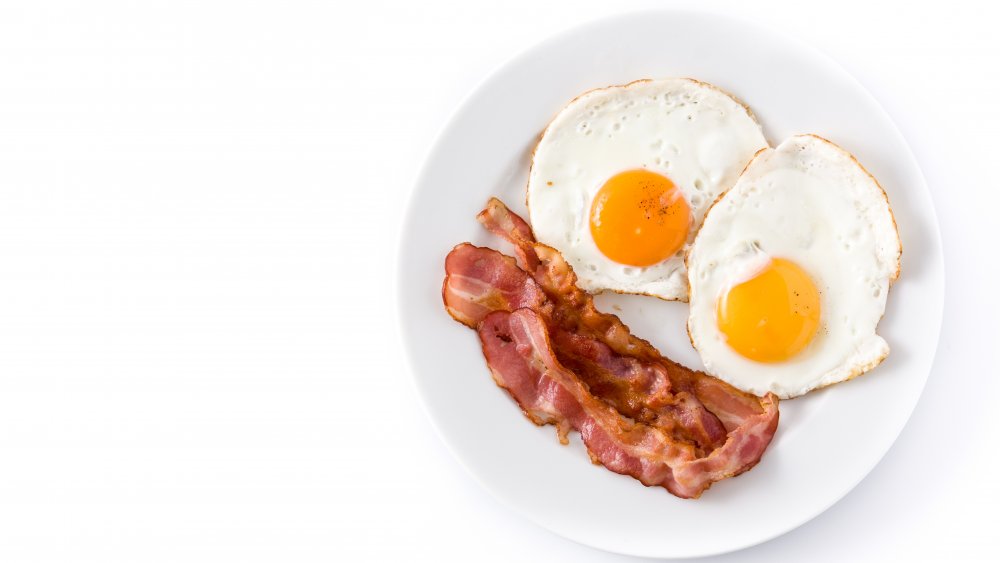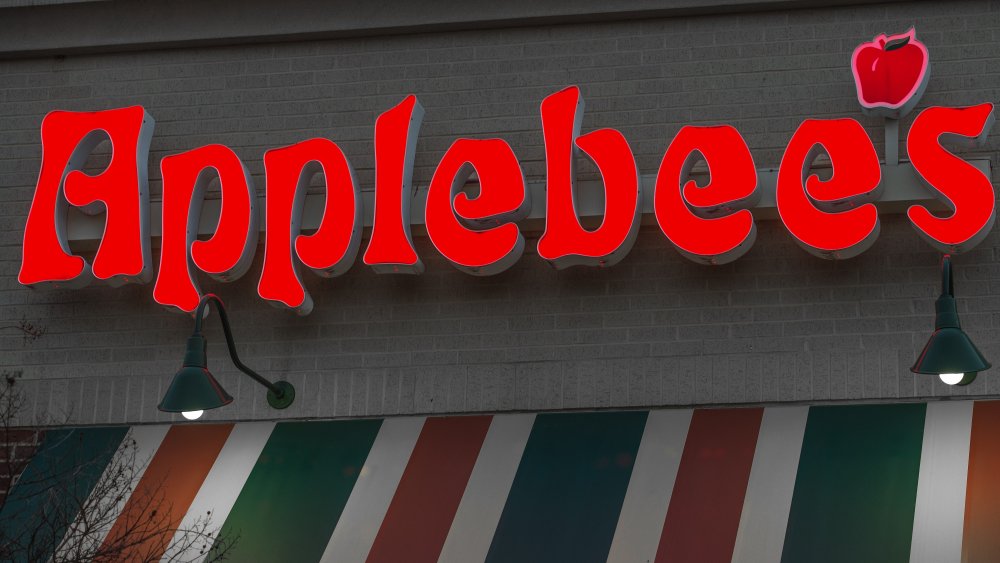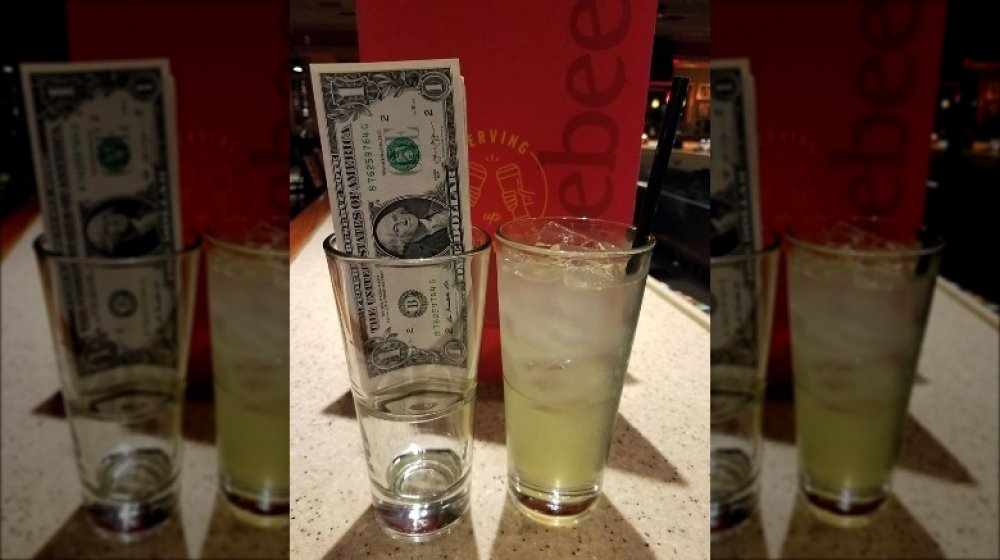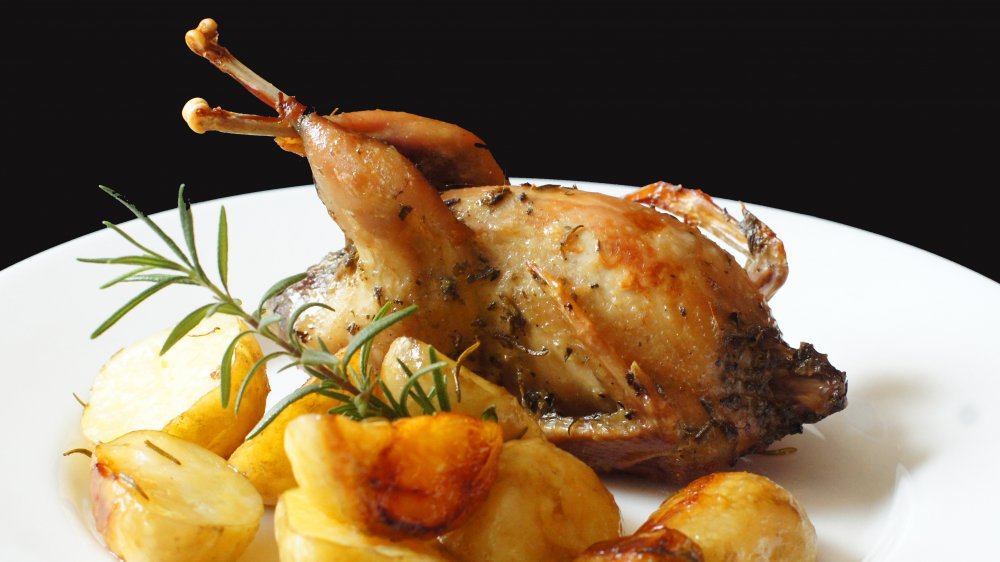The Untold Truth Of Applebee's
Applebee's bills itself as a "Neighborhood Bar and Grill," and with more than a thousand locations worldwide, chances are there's one in a neighborhood near you. The restaurant chain is ubiquitous enough to have appeared in movies like Talladega Nights, Couple's Retreat, Hall Pass, and Why Him; it's been referenced in the lyrics of songs by artists like Drake, Brad Paisley, and DJ Jazzy Jeff; and it's even welcomed celebrity diners, like the members of band LMFAO, to its tables.
But there's still a lot you might not know about Applebee's. The company is a lot older than you might think, and from name changes to major acquisitions, it's gone through a lot of changes over the years.
You may think of it as just another restaurant, but as with most businesses, there's always more to the story. What is Club Applebee's? How safe is the food at Applebee's? And what's the deal with the Dollarita? The answers to these questions tell the story of a restaurant chain that's managed to find success during several tumultuous decades, but also faced some troubling times.
This is the untold truth of Applebee's.
Applebee's has been open for 40 years
Applebee's is a fixture of malls and hotel-adjacent parking lots, but though it seems like a mainstay of modern life, it turns out that this restaurant has been around for a long time — 40 years, to be exact.
The business was started by Bill and TJ Palmer in 1980, who opened their first restaurant in Atlanta, Georgia. Since then the business has been sold several times. The duo first sold their restaurant concept to W.R. Grace and Company in 1983, and in 1989 they completed an IPO and started selling shares of their stock on the market.
One of the things that set Applebee's apart from other chain restaurants was their focus on being a "neighborhood" restaurant. Franchise managers were allowed to hand-pick certain items on their menu (though all of the restaurants needed to serve the chain's signature riblets, fajitas, and apple margaritas) so they could tailor the food to local tastes. They were also encouraged to decorate their restaurants with some unique local flair, and to get involved with local charities and fundraising events.
Though in recent years it has had to close some locations, after 40 years, Applebee's still has a strong presence in the chain restaurant game, and actually had a bit of a comeback in 2018.
There are a lot more Applebee's locations than you think
Applebee's strives to be a neighborhood restaurant, and chances are there's one near your neighborhood. That's because there are now nearly 2,000 Applebee's locations across the country and worldwide.
The restaurant started out humbly in the '80s, growing at a slow and steady crawl to 100 restaurants by the end of that decade. Four years later, in 1994, they had ballooned to 500 restaurants, and by 1998 they had doubled that number to 1,000.
As of 2018, the chain had 1,693 restaurants operating in the United States (which includes 69 company-owned locations and 1,624 franchises), and there are 144 locations operating internationally.
If you're abroad and craving some riblets or an apple margarita, you could try visiting an Applebee's in Brazil, Greece, Indonesia, Lebanon, China, Egypt, Qatar, or one of the other 15 countries where they're up and running. The company could also be an option for those seeking a new job — they currently employ almost 28,000 people worldwide.
There might be plastic in the food served at Applebee's
Tender barbecued riblets. A tangy margarita. Plastic-coated broccoli and expired mashed potatoes? Two of these things are not like the others, but apparently all are sold at Applebee's, according a reporter who went undercover at Applebee's to figure out what exactly goes into their food.
The first troubling fact Tracie McMillan, the author of The American Way of Eating: Undercover at Walmart, Applebee's, Farm Fields and the Dinner Table, shared, was that when she started working at Applebee's, she received no formal food safety training. McMillan said that it seemed like her fellow employees were similarly untrained, exemplified by one instance where she was told to heat up a tray of mashed potatoes that was two days past its expiration date, so that it could be served to customers. She brought up her concerns but was simply told "You're going to see a lot of things here."
Another issue was that the side dishes came pre-portioned in small containers, which were then mixed with a sauce, placed in a plastic bag, and microwaved. After being exposed to the heat, the broccoli would be served covered in flakes of plastic from the bag.
If you want to avoid any of these potentially sketchy foods, McMillan recommends selecting items off the grill. "Burgers, steaks and fish are industrial meat and are defrosted and cooked," she says, so you can easily tell if they're being prepared properly or not. She also recommends the french fries.
There's a way to eat cheap at Applebee's
Dining out and saving money don't always go hand in hand. In general, though, Applebee's keeps things reasonable, with a large selection of entrees under $15, and appetizers under $11.
But if you're really looking to score a bargain, you should head to your neighborhood Applebee's on weeknights after 9 p.m., or on weekends after 10 p.m. That's because they have a late-night happy hour at most locations, when you can score half-price appetizers, discounted adult beverages, and, sometimes, $1 cocktails. Certain Applebee's may also have a late-afternoon happy hour between 3-6 p.m.
Some of the appetizers you might find at your local Applebee's for happy hour prices include boneless wings, mozzarella sticks, and spinach and artichoke dip.
If you can't stay up late enough to take advantage of the late night deal, or don't get out of work early enough for the afternoon happy hour, you may be interested in their 2 for $20 meals (price may vary by location). With this deal, you can order two entrees and one appetizer for just $20, which is a pretty decent price for a two person meal at a restaurant. Appetizer options include onion rings and boneless wings, and entree selections include sirloin steak, chicken tenders, riblets, pasta, and more.
IHOP bought Applebee's for $2.1 billion
Applebee's has a long acquisition and sales history. They're no stranger to buying up other chains — the company has, over time, owned smaller chains (like Rio Bravo Cantina), sold those smaller chains (Rio Bravo was sold to Chevy's in 1999), and been sold themselves.
But the biggest sale in the company's history occurred in 2007, when it was purchased by IHOP Corp. for $2.1 billion. The two restaurants together became the largest full-service restaurant company in the world. After the sale, IHOP Corp. changed its name to DineEquity, Inc., which is today known as Dine Brands Global, Inc.
Today, Dine Brands Global, Inc. operates more than 3,700 restaurants in 18 countries, and it oversees the franchising of both restaurant chains.
The acquisition of Applebee's by IHOP is considered to be one of the biggest restaurant sales of the past 20 years. Though both chains have faced recent hardships, it looks like Applebee's is at least on its way back up. In 2017, Dine Brands Global announced that they would be closing 100 Applebee's and 20 or more IHOP locations, and noted that sales had fallen at both chains. However, sales at Applebee's were up 5.5 percent in 2018, after their parent company got a new CEO and they adjusted elements of their menu and employment practices.
Some Applebee's turn into wild night clubs after 10 pm
Applebee's is open late, and their late-night happy hour is quite the draw. But in some cities in Florida, there's an even more exciting reason to head to your neighborhood bar and grill – Club Applebee's, or Club 'Bee's for short.
In the early 2010s, some Applebee's locations in Florida and across the south began turning into Club Applebee's after 10 p.m., loud nightclubs with music, dancing, and drinks flowing until 2 a.m.
At one time, about 100 Applebee's restaurants across the south turned into Club Applebee's at night, though it looks like now most Club Applebee's locations are in Florida. These locations host the usual dance nights, but also special events like karaoke night and blacklight parties.
Apparently, as the night gets rowdy, drinks start to be served in plastic cups instead of glass, people dance on the bar, and DJs blast dance music while disco balls and flashing lights illuminate the restaurants.
Club Applebee's isn't officially organized by corporate, and seems to be something that individual franchisees can decide to host at their locations. If you live in Florida, you can look for a "Club 'Bee's" near you using their website.
Applebee's doesn't share any of their recipes
If you've ever fallen in love with a particular menu item at a restaurant, chances are you've tried to find a way to make it at home. Whether you're trying to make a KFC chicken copycat recipe with the correct blend of 11 herbs and spices or trying to hack some copycat Chipotle recipes to bring to work so you can save money at lunch, it's fun to recreate your fave restaurant recipes at home.
Unfortunately, if you're jonesing for Applebee's spinach and artichoke dip or boneless wings and don't have a restaurant nearby, you might be out of luck. That's because the chain is notorious for keeping their recipes top-secret. Any Applebee's recipes you see posted online are most likely fakes, or merely attempts from fans to make their favorite dishes at home.
As far as we can tell, the closest the restaurant has come to officially revealing one of their recipes was when in 1997 an Applebee's manager in South Hill, Washington, shared how they make their Asian chicken salad – minus the recipe for the salad dressing, which some could argue is what makes the dish so special. He recommended buying the dressing at your local Applebee's.
Applebee's has won awards for being a great employer
Employee turnover is a big problem in the restaurant industry. The Bureau of Labor Statistics says that restaurants saw an 81.9 percent turnover rate for 2015-2017, meaning that each year 81.9 percent of the workforce was replaced with new employees, but others in the restaurant industry say the number is much higher — maybe even as much as 150 percent.
Applebee's isn't immune to issues with employee turnover rates. In 2000, they experienced an employee turnover rate of 146 percent. However, over the years they've tried several different methods for reducing turnover and increasing employee retention. In fact, by 2004 they had reduced their turnover to 84 percent.
These days, the company uses "gamification" to improve employee retention, letting staff earn points and prizes for jobs well done, and it seems like their efforts to create a welcoming workplace are working.
The company has won several awards for its employment practices, including the Nation's Restaurant News Excellence in Retention Award, the People Report Heart of the Workplace Award (which recognizes workplaces that make "a difference in the lives of their employees and their communities"), the People Report Top Performer in Management Retention Award, and the People Report Catalyst Award (which rewarded "Applebee's creative implementation of new competition, recognition and rewards programs to significantly reduce hourly and management turnover").
Applebee's sources humane eggs and pork
Sure, they might serve expired mashed potatoes and broccoli coated in plastic flakes, but when it comes to eggs and pork, Applebee's is doing a much better job serving a product they can be proud of.
In 2013, the company that owns Applebee's and IHOP announced it would no longer source pork from farmers that use gestation crates for any of their 3,500+ restaurants.
They pledged that by 2020, the company would cease using gestation crate pork entirely, saying that they wanted to feature "ingredients that are produced and sourced as responsibly and sustainably as possible."
While the company started making moves to use more cage-free eggs in 2008, it was in 2016 when they announced that both Applebee's and IHOP would go 100 percent cage-free by 2025. They said the move was both because of consumer expectations, and because of the company's "commitment to animal welfare." The reason for the switch taking so long? Farmers need time to catch up with the new demand for cage-free eggs, so they can modify their farms and move away from the use of battery cages (which have been banned in the European Union since 2013).
Applebee's isn't the only chain restaurant that's gone cage-free in recent years. They're joining businesses like Taco Bell, Sonic Drive-In, and Denny's in changing how they source their eggs, which makes us wonder if soon, cage-free eggs will be the new norm.
The name Applebee's was picked out of a phone book
How does one go about naming a restaurant? For Bill and TJ Palmer, the brains behind Applebee's, the answer was simple — flip through a phone book.
Initially, they wanted to name their restaurant Appleby, which was a name they found in the phone book. However, that name they chose had actually been copyrighted just two weeks prior. Other names they considered included Cinnamon's and Pepper's, but both of those had already been taken by other restaurants, too. Instead, they settled on a slightly modified version of their original favorite: Applebee's.
Before the chain went simply by Applebee's, however, it had a much longer name: T.J. Applebee's Rx for Edibles & Elixirs. It was originally decorated with an old-time drugstore theme, before the restaurant eventually pivoted to its current neighborhood bar and grill vibe.
When Bill and his wife TJ had a falling out, they sold the business to W.R Grace and Co., and that company then changed the restaurant's name to Applebee's Neighborhood Grill & Bar in 1986, six years after the first T.J. Applebee's Rx for Edibles & Elixirs opened.
Their $1 margaritas may have saved Applebee's
2017 was a rough year for Applebee's. The chain closed 99 locations that year alone, and they also planned closures of 60 to 80 restaurants in 2018. Part of the problem, according to the brand president, was that they were having a hard time attracting millennial customers.
Luckily for them, everything started changing in September of 2017. Their parent company got a new CEO, and a month later, Applebee's introduced the Dollarita, a $1 margarita.
It may seem gimmicky, but it turns out that the Dollarita is behind the restaurant's turn around in 2018. Sales were up 5.5 percent, and the company was so inspired by the success of the Dollarita that they started offering other limited-time beverages for between $1-$3 each month. Applebee's saw four quarters in a row of growth after the drink's introduction.
CEO Steve Joyce says that "Dollarita turned everything around...It was a 13-point swing between September and October in Applebee's performance."
Not all franchise-operated restaurants were keen on adding the dollar drink to their menus initially, fearing that people would come in for cheap drinks and not order food, but according to Joyce, "Ninety-eight percent of the people who came in and ordered those, ordered food." People came for the dollar cocktails, ordered some food to go with it, and sales soared at Applebee's for the first time in years.
The menu used to include quail and gumbo
These days, Applebee's is known for its pub grub like burgers, steak, riblets, chicken tenders, and appetizers, but back in the day their menu was a bit more interesting.
When it was still called T.J. Applebee's Rx for Edibles & Elixirs, one newspaper reviewed the menu, saying that the restaurant offered "menu items ranging from munchies to steak and quail."
Applebee's also apparently sold quiche, which was very trendy in the '80s, and one of the restaurant's top-sellers was gumbo.
The chain used to let managers put their own touch on the menu to better appeal to local tastes, and back in the day that meant some locations in Texas had chicken-fried steak on the menu, while Boston restaurants served up seafood gumbo (seafood and Boston make sense together, though we're not sure why the pairing took the form of gumbo, which originated in Louisiana).
You won't find gumbo or quail on the modern day Applebee's menu. These days, their focus is on meaty entrees like steak and ribs; sizzling fajita platters; pub-style appetizers; and chicken entrees.
